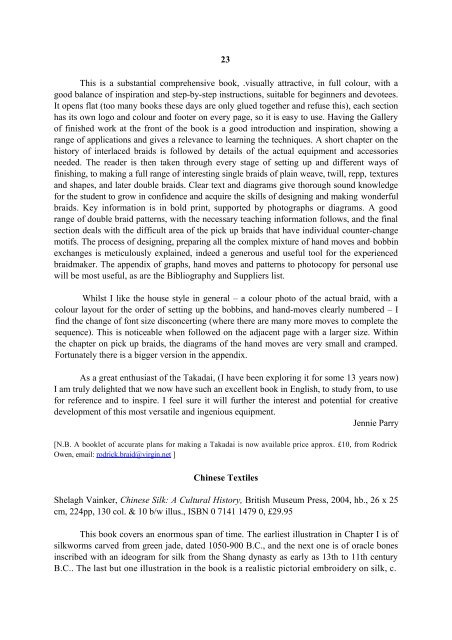download - OATG. Oxford Asian Textile Group
download - OATG. Oxford Asian Textile Group
download - OATG. Oxford Asian Textile Group
You also want an ePaper? Increase the reach of your titles
YUMPU automatically turns print PDFs into web optimized ePapers that Google loves.
23<br />
This is a substantial comprehensive book, .visually attractive, in full colour, with a<br />
good balance of inspiration and step-by-step instructions, suitable for beginners and devotees.<br />
It opens flat (too many books these days are only glued together and refuse this), each section<br />
has its own logo and colour and footer on every page, so it is easy to use. Having the Gallery<br />
of finished work at the front of the book is a good introduction and inspiration, showing a<br />
range of applications and gives a relevance to learning the techniques. A short chapter on the<br />
history of interlaced braids is followed by details of the actual equipment and accessories<br />
needed. The reader is then taken through every stage of setting up and different ways of<br />
finishing, to making a full range of interesting single braids of plain weave, twill, repp, textures<br />
and shapes, and later double braids. Clear text and diagrams give thorough sound knowledge<br />
for the student to grow in confidence and acquire the skills of designing and making wonderful<br />
braids. Key information is in bold print, supported by photographs or diagrams. A good<br />
range of double braid patterns, with the necessary teaching information follows, and the final<br />
section deals with the difficult area of the pick up braids that have individual counter-change<br />
motifs. The process of designing, preparing all the complex mixture of hand moves and bobbin<br />
exchanges is meticulously explained, indeed a generous and useful tool for the experienced<br />
braidmaker. The appendix of graphs, hand moves and patterns to photocopy for personal use<br />
will be most useful, as are the Bibliography and Suppliers list.<br />
Whilst I like the house style in general – a colour photo of the actual braid, with a<br />
colour layout for the order of setting up the bobbins, and hand-moves clearly numbered – I<br />
find the change of font size disconcerting (where there are many more moves to complete the<br />
sequence). This is noticeable when followed on the adjacent page with a larger size. Within<br />
the chapter on pick up braids, the diagrams of the hand moves are very small and cramped.<br />
Fortunately there is a bigger version in the appendix.<br />
As a great enthusiast of the Takadai, (I have been exploring it for some 13 years now)<br />
I am truly delighted that we now have such an excellent book in English, to study from, to use<br />
for reference and to inspire. I feel sure it will further the interest and potential for creative<br />
development of this most versatile and ingenious equipment.<br />
Jennie Parry<br />
[N.B. A booklet of accurate plans for making a Takadai is now available price approx. £10, from Rodrick<br />
Owen, email: rodrick.braid@virgin.net ]<br />
Chinese <strong>Textile</strong>s<br />
Shelagh Vainker, Chinese Silk: A Cultural History, British Museum Press, 2004, hb., 26 x 25<br />
cm, 224pp, 130 col. & 10 b/w illus., ISBN 0 7141 1479 0, £29.95<br />
This book covers an enormous span of time. The earliest illustration in Chapter I is of<br />
silkworms carved from green jade, dated 1050-900 B.C., and the next one is of oracle bones<br />
inscribed with an ideogram for silk from the Shang dynasty as early as 13th to 11th century<br />
B.C.. The last but one illustration in the book is a realistic pictorial embroidery on silk, c.
















